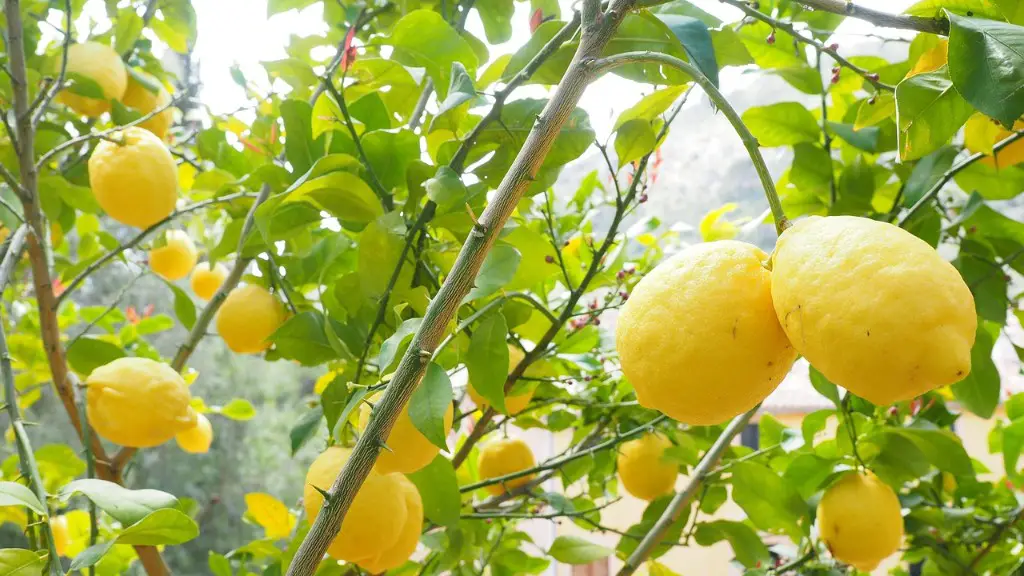Meyer lemon trees (Citrus x meyeri) are prized for their large, fragrant and prolific fruits. However, if their leaves start curling, this could be a cause for concern. The most common causes of curled leaves on Meyer lemon trees are environmental stressors or pests. Understanding the cause and taking steps to correct the issue are essential to maintaining healthy growth and avoiding the spread of disease.
Environmental stressors like improper watering, temperature changes, and inadequate sunlight are the most common cause of curled leaves on a Meyer lemon tree. For instance, under or over-watering the tree can cause the leaves to curl as a result of insufficient access to water, as can extreme direct sunlight or sudden drastic temperature changes. Improving the soil quality and adjusting elements such as the moisture and temperature levels around the tree are essential for avoiding further damage.
Pests such as mites, insects, and scale can also cause the leaves of a Meyer lemon tree to curl. These pests are easily identifiable, often appearing as collections of small, raised bumps on the tree, and their presence can be confirmed by examining the leaves under a microscope. Once this has been established, an infestation can be treated to rid the tree of insects and keep the leaves healthy. Fungal, bacterial and viral diseases can also cause leaf curling and should be identified and treated by a tree care professional.
When it comes to reviving a Meyer lemon tree with curled leaves, the most important preventive measure is to create a stress-free, disease-resistant environment. Adequate watering, regular fertilization, and proper sunlight exposure are essential for optimum growth, as well as avoiding ambient temperature changes that could harm the tree. If pests have been identified, control strategies and treatments must be employed in order to eliminate their presence. Approaches such as chemical removal, biological control, and natural methods should all be considered when combating an infestation.
Overall, curled leaves on a Meyer lemon tree can be an indication of multiple environmental, fungal or pest-based issues. Understanding the underlying cause is essential to restoring the health of the tree and ensuring future growth. Environmental improvements, along with chemical and biological treatments, can be used to eliminate pests and diseases, as well as provide the necessary conditions for optimal growth. Proper management and maintenance of a Meyer lemon tree will help maximize the yield and ensure strong health.
Environmental Stressors
Environmental stressors such as extreme temperature changes, insufficient access to water, and inadequate sunlight can cause curled leaves on Meyer lemon trees. Therefore, it is essential to improve the soil quality and make adjustments to the moisture and temperature levels around the tree to avoid further damage. Additionally, ensuring the tree gets adequate sunlight exposure is also key to maintaining healthy growth and avoiding disease.
Frequent monitoring of the tree is necessary to identify any issues from the earliest stages. If a tree is severely dehydrated, supplemental water might be needed in order to help the tree recover and retain its leaves. Avoiding direct sunlight and taking steps to protect the tree from extreme temperatures can also help. Additionally, regularly checking the soil to ensure it is rich in nutrients and free of excessive salts or chemicals is important for optimum growth.
Furthermore, it’s also important to properly prune the tree and remove any dead leaves, branches, or flowers. This is important to ensure that the tree maintains a healthy balance and growth, preventing any damage or disease that could be caused by these elements. Taking immediate action when environmental stressors are detected can help limit the impact and ensure healthy growth.
Pests and Disease
Common pests such as mites, insects, and scale can cause curled leaves on Meyer lemon trees. These pests are easily identifiable and their presence can be confirmed by examining the leaves under a microscope. Once identified, an infestation can be treated to rid the tree of insects and restore the leaves’ health. Proper pest control strategies and treatments should be employed to eliminate their presence and limit the spread of any diseases.
Fungal, bacterial and viral diseases can also cause leaf curling and should be identified and treated by a tree care professional. These diseases can spread quickly and have a negative effect on the trees’ health, so it’s important to intervene as soon as any symptoms are identified. Chemical and biological treatments may be necessary to eliminate these diseases, as well as providing a preventative measure against further infection.
Certain environmental factors can also contribute to an increase in pest or disease issues. For instance, inadequate nutrient availability or improperly adjusted soil pH levels may lead to a higher risk of infestation or disease. Ensuring the tree is well-nourished and has access to healthy growth soil can help prevent these issues.
In addition, any physical damage the tree has sustained from storms, wind, or other natural events should be monitored and addressed. The tree may be more vulnerable to pest and disease infestations, so it’s important to protect it as best as possible with pest control strategies, as well as any other protective measures.
Preventative Measures and Revival of the Tree
The most important preventative measure for reviving a Meyer lemon tree with curled leaves is to create a stress-free, disease-resistant environment. Adequate and consistent watering, regular fertilization, and an optimal amount of sunlight exposure are all essential for healthy growth. Additionally, protective measures such as avoiding direct exposure to sunlight and preventing excessive temperature changes can help protect the tree and ensure future health.
If a pest or disease issue is discovered, immediate action should be taken. Pest control strategies and treatments can be employed to eliminate their presence, such as chemical removal, biological control, and natural methods. Fungal, bacterial, or viral diseases should also be identified and treated by a tree care professional to ensure their spread is stopped and the tree’s health is restored.
Overall, maintaining a healthy growth environment and providing adequate care are essential for preventing issues such as curled leaves on a Meyer lemon tree. Proper management and attention to the tree can help ensure the growth and yield of the fruit are maximized, and that the Meyer lemon tree remains in optimal health.



